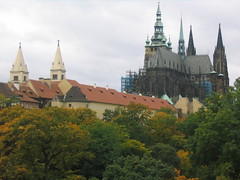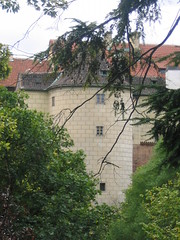By Stuart Frost
 ‘It is generally agreed amongst the Catholics in Prague that the Emperor has been bewitched and is in league with the devil. I have been shown the chair in which His Majesty sits when holding conversations with the Prince of Darkness himself. I have seen the little bell His Majesty uses whenever he wished to summon the spirits of the departed to do his bidding.’
‘It is generally agreed amongst the Catholics in Prague that the Emperor has been bewitched and is in league with the devil. I have been shown the chair in which His Majesty sits when holding conversations with the Prince of Darkness himself. I have seen the little bell His Majesty uses whenever he wished to summon the spirits of the departed to do his bidding.’
Cardinal Filippo Spinelli writing to Pope Clement VIII, 1600 (Quote from Hans Holzer, The Alchemist, New York 1985) 85 & 91.
Whilst we can’t take the passage I’ve quoted above too literally there is no doubt that the Emperor Rudolph II was an interesting character. Rudolph had a deep interest in both alchemy and scientific enquiry. It is clear that some of the people who enjoyed his patronage did stray into territory that could be described as occult. On a cold, damp and dark October evening the corridors and courtyards of Pražský hrad, or Prague castle, take on a slightly Faustian atmosphere. It isn’t too difficult to imagine an alchemist in the Powder Tower working late into the night and straying into supernatural territory.
The bronze bust of the Emperor Rudolph in the V&A’s collections conjures up an unambiguous impression of a ruler who is not to be crossed. The powerful profile and jutting jaw convey a strong sense of a man who is confident, determined, decisive and authoritative. He wears armour decorated with a lion’s mask and an image of the classical hero Hercules. The bust is supported by the outstretched wings of an imperial eagle. The impression created the sculptor Adriaen de Vries is deliberately deceptive.
 The bust was made in 1609 by which time Rudolph had little meaningful power or authority. Although depicted in armour, he never actually led an army into battle. Indeed he rarely left Prague Castle. He preferred to spend his time studying his vast collection of art, scientific instruments and natural wonders. Rudolph’s great collection once filled many of the rooms of the vast castle that still dominates Prague. The V&A’s bust itself was once part of the collection there.
The bust was made in 1609 by which time Rudolph had little meaningful power or authority. Although depicted in armour, he never actually led an army into battle. Indeed he rarely left Prague Castle. He preferred to spend his time studying his vast collection of art, scientific instruments and natural wonders. Rudolph’s great collection once filled many of the rooms of the vast castle that still dominates Prague. The V&A’s bust itself was once part of the collection there.
I’ve illustrated this blog-entry with several photographs which I took last week when working in Prague on the third in a series of three People & Place gallery films. Regular readers of this blog will already have read about Charlemagne and Aachen, and Donatello and Florence. With the Rudolph and Prague film we’re hoping to give visitors insights into the man portrayed in bronze, the world in which he lived and the context to which his bronze bust belonged.
 I felt extremely fortunate to be able to spend a few days following in Rudolph’s footsteps and tapping into curator Norbert Jopek’s specialist knowledge. Whilst I’m delighted that the films we first thought about making several years ago have now begun come to fruition, I have to confess that I’m a little saddened that the location filming has already come to an end. It has been fantastic to work with the curatorial team and to see the depth of their enthusiasm for their subjects. It has also been a real pleasure to work with John Wyver, Linda Zuck and Ian Serfontein of Illuminations.
I felt extremely fortunate to be able to spend a few days following in Rudolph’s footsteps and tapping into curator Norbert Jopek’s specialist knowledge. Whilst I’m delighted that the films we first thought about making several years ago have now begun come to fruition, I have to confess that I’m a little saddened that the location filming has already come to an end. It has been fantastic to work with the curatorial team and to see the depth of their enthusiasm for their subjects. It has also been a real pleasure to work with John Wyver, Linda Zuck and Ian Serfontein of Illuminations.
Our main aspiration for the trio of films is to enhance vistors’ understanding of three key objects, artworks from a time that might seem too remote to have real meaning. We also hope that the films will inspire some visitors to the galleries to travel to the continent and to explore Europe’s rich medieval and Renaissance heritage at first hand. Travelling to just three different locations has given me a vivid reminder of just how great Europe’s medieval and Renaissance heritage really is.
Click here to find out a little more about Prague Castle.
I can’t wait to see these short films. Adding understanding and value to an object in an accesible format such as film is always going to be interesting from an interpreative point of view. Are there plans to make these films available on the web or handheld devices such as mobiles?
The film is now available online. Please click here to see it:
http://www.vimeo.com/7792712